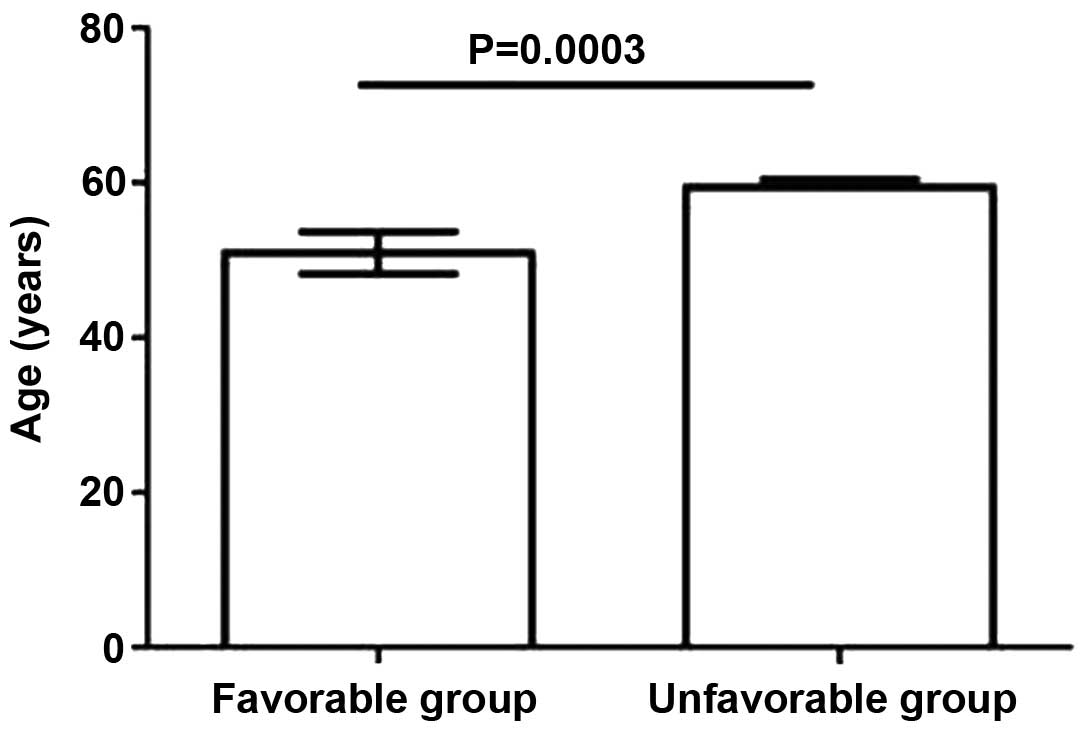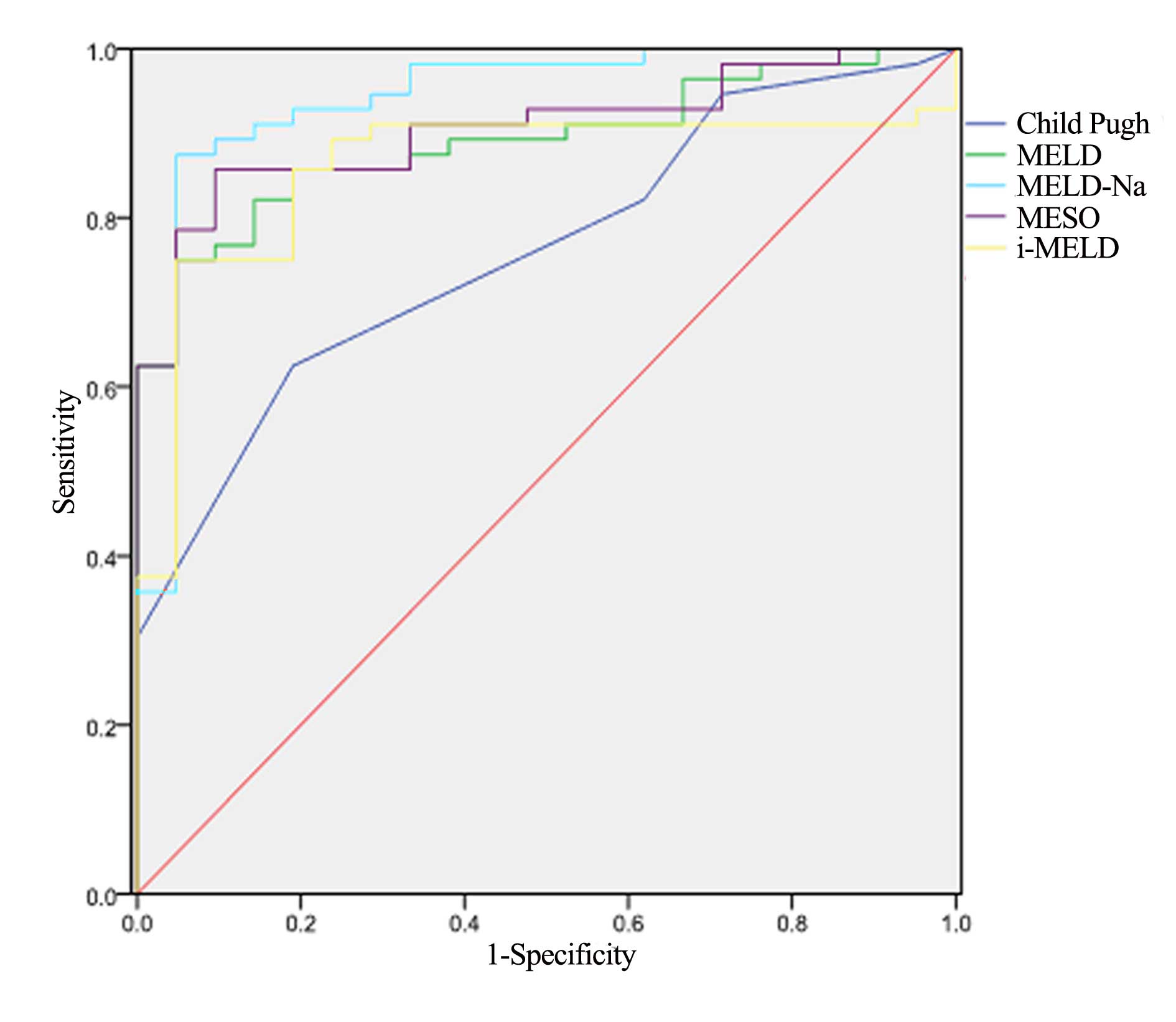|
1
|
Fan HL, Yang PS, Chen HW, Chen TW, Chan
DC, Chu CH, Yu JC, Kuo SM and Hsieh CB: Predictors of the outcomes
of acute-on-chronic hepatitis B liver failure. World J
Gastroenterol. 18:5078–5083. 2012. View Article : Google Scholar : PubMed/NCBI
|
|
2
|
Jalan R, Gines P, Olson JC, Mookerjee RP,
Moreau R, Garcia-Tsao G, Arroyo V and Kamath PS: Acute-on chronic
liver failure. J Hepatol. 57:1336–1348. 2012. View Article : Google Scholar : PubMed/NCBI
|
|
3
|
Wigg AJ, McCormick R, Wundke R and Woodman
RJ: Efficacy of a chronic disease management model for patients
with chronic liver failure. Clin Gastroenterol Hepatol.
11:850–858.e4. 2013. View Article : Google Scholar : PubMed/NCBI
|
|
4
|
Finkenstedt A, Nachbaur K, Zoller H,
Joannidis M, Pratschke J, Graziadei IW and Vogel W:
Acute-on-chronic liver failure: Excellent outcomes after liver
transplantation but high mortality on the wait list. Liver Transpl.
19:879–886. 2013. View
Article : Google Scholar : PubMed/NCBI
|
|
5
|
Katoonizadeh A, Laleman W, Verslype C,
Wilmer A, Maleux G, Roskams T and Nevens F: Early features of
acute-on-chronic alcoholic liver failure: A prospective cohort
study. Gut. 59:1561–1569. 2010. View Article : Google Scholar : PubMed/NCBI
|
|
6
|
Lucey MR, Brown KA, Everson GT, Fung JJ,
Gish R, Keeffe EB, Kneteman NM, Lake JR, Martin P, McDiarmid SV, et
al: Minimal criteria for placement of adults on the liver
transplant waiting list: A report of a national conference
organized by the American Society of Transplant Physicians and the
American Association for the Study of Liver Diseases. Liver Transpl
Surg. 3:628–637. 1997. View Article : Google Scholar : PubMed/NCBI
|
|
7
|
Kamath PS, Wiesner RH, Malinchoc M,
Kremers W, Therneau TM, Kosberg CL, D'Amico G, Dickson ER and Kim
WR: A model to predict survival in patients with end-stage liver
disease. Hepatology. 33:464–470. 2001. View Article : Google Scholar : PubMed/NCBI
|
|
8
|
Xun YH, Shi JP, Li CQ, Li D, Shi WZ, Pan
QC, Guo JC and Zang GQ: Prognostic performance of a series of model
for end-stage liver disease and respective Δ scores in patients
with hepatitis B acute-on-chronic liver failure. Mol Med Rep.
9:1559–1568. 2014.PubMed/NCBI
|
|
9
|
Shi Y, Yang Y, Hu Y, Wu W, Yang Q, Zheng
M, Zhang S, Xu Z, Wu Y, Yan H and Chen Z: Acute-on-chronic liver
failure precipitated by hepatic injury is distinct from that
precipitated by extrahepatic insults. Hepatology. 62:232–242. 2015.
View Article : Google Scholar : PubMed/NCBI
|
|
10
|
Sarin SK, Kumar A, Almeida JA, Chawla YK,
Fan ST, Garg H, de Silva HJ, Hamid SS, Jalan R, Komolmit P, et al:
Acute-on-chronic liver failure: Consensus recommendations of the
Asian Pacific Association for the Study of the Liver (APASL).
Hepatol Int. 3:269–282. 2009. View Article : Google Scholar : PubMed/NCBI
|
|
11
|
Ferenci P, Lockwood A, Mullen K, Tarter R,
Weissenborn K and Blei AT: Hepatic encephalopathy - definition,
nomenclature, diagnosis and quantification: Final report of the
Working Party at the 11th World Congresses of Gastroenterology,
Vienna, 1998. Hepatology. 35:716–721. 2002. View Article : Google Scholar : PubMed/NCBI
|
|
12
|
Huo TI, Wang YW, Yang YY, Lin HC, Lee PC,
Hou MC, Lee FY and Lee SD: Model for end-stage liver disease score
to serum sodium ratio index as a prognostic predictor and its
correlation with portal pressure in patients with liver cirrhosis.
Liver Int. 27:498–506. 2007. View Article : Google Scholar : PubMed/NCBI
|
|
13
|
Lee W, Squires RH Jr, Nyberg SL, Doo E and
Hoofnagle JH: Acute liver failure: Summary of a workshop.
Hepatology. 47:1401–1415. 2008. View Article : Google Scholar : PubMed/NCBI
|
|
14
|
Ostapowicz G, Fontana RJ, Schiødt FV,
Larson A, Davern TJ, Han SH, McCashland TM, Shakil AO, Hay JE,
Hynan L, et al: Results of a prospective study of acute liver
failure at 17 tertiary care centers in the United States. Ann
Intern Med. 137:947–954. 2002. View Article : Google Scholar : PubMed/NCBI
|
|
15
|
Lal J, Thapa BR, Rawal P, Ratho RK and
Singh K: Predictors of outcome in acute-on-chronic liver failure in
children. Hepatol Int. 5:693–697. 2011. View Article : Google Scholar : PubMed/NCBI
|
|
16
|
Wasmuth HE, Kunz D, Yagmur E,
Timmer-Stranghöner A, Vidacek D, Siewert E, Bach J, Geier A,
Purucker EA, Gressner AM, et al: Patients with acute on chronic
liver failure display ‘sepsis-like’ immune paralysis. J Hepatol.
42:195–201. 2005. View Article : Google Scholar : PubMed/NCBI
|
|
17
|
Crippin JS, Gross JB Jr and Lindor KD:
Increased intracranial pressure and hepatic encephalopathy in
chronic liver disease. Am J Gastroenterol. 87:879–882.
1992.PubMed/NCBI
|
|
18
|
Jalan R, Dabos K, Redhead DN, Lee A and
Hayes PC: Elevation of intracranial pressure following transjugular
intrahepatic portosystemic stent-shunt for variceal haemorrhage. J
Hepatol. 27:928–933. 1997. View Article : Google Scholar : PubMed/NCBI
|
|
19
|
Donovan JP, Schafer DF, Shaw BW Jr and
Sorrell MF: Cerebral edema and increased intracranial pressure in
chronic liver disease. Lancet. 351:719–721. 1998. View Article : Google Scholar : PubMed/NCBI
|
|
20
|
Olson JC, Wendon JA, Kramer DJ, Arroyo V,
Jalan R, Garcia-Tsao G and Kamath PS: Intensive care of the patient
with cirrhosis. Hepatology. 54:1864–1872. 2011. View Article : Google Scholar : PubMed/NCBI
|
|
21
|
Cremers I and Ribeiro S: Management of
variceal and nonvariceal upper gastrointestinal bleeding in
patients with cirrhosis. Therap Adv Gastroenterol. 7:206–216. 2014.
View Article : Google Scholar : PubMed/NCBI
|
|
22
|
Bumaschny E, Doglio G, Pusajó J, Vetere L,
Parra C, Grosso RM and Schieppati E: Postoperative acute
gastrointestinal tract hemorrhage and multiple-organ failure. Arch
Surg. 123:722–726. 1988. View Article : Google Scholar : PubMed/NCBI
|
|
23
|
Solís-Muñoz P: Acute on chronic liver
failure and prognostic factors: Time for reevaluation. Rev Esp
Enferm Dig. 103:169–176. 2011.PubMed/NCBI
|
|
24
|
Wiesner R, Edwards E, Freeman R, Harper A,
Kim R, Kamath P, Kremers W, Lake J, Howard T, Merion RM, et al:
Model for end-stage liver disease (MELD) and allocation of donor
livers. Gastroenterology. 124:91–96. 2003. View Article : Google Scholar : PubMed/NCBI
|
|
25
|
Arroyo V and Colmenero J: Ascites and
hepatorenal syndrome in cirrhosis: Pathophysiological basis of
therapy and current management. J Hepatol. 38(Suppl 1): S69–S89.
2003. View Article : Google Scholar : PubMed/NCBI
|
|
26
|
Schrier RW, Gurevich AK and
Cadnapaphornchai MA: Pathogenesis and management of sodium and
water retention in cardiac failure and cirrhosis. Semin Nephrol.
21:157–172. 2001. View Article : Google Scholar : PubMed/NCBI
|
|
27
|
Malinchoc M, Kamath PS, Gordon FD, Peine
CJ, Rank J and ter Borg PC: A model to predict poor survival in
patients undergoing transjugular intrahepatic portosystemic shunts.
Hepatology. 31:864–871. 2000. View Article : Google Scholar : PubMed/NCBI
|
|
28
|
Conn HO: A peek at the Child-Turcotte
classification. Hepatology. 1:673–676. 1981. View Article : Google Scholar : PubMed/NCBI
|
|
29
|
Al Sibae MR and Cappell MS: Accuracy of
MELD scores in predicting mortality in decompensated cirrhosis from
variceal bleeding, hepatorenal syndrome, alcoholic hepatitis, or
acute liver failure as well as mortality after non-transplant
surgery or TIPS. Dig Dis Sci. 56:977–987. 2011. View Article : Google Scholar : PubMed/NCBI
|
|
30
|
Kumar R, Krishnamoorthy TL, Tan HK, Lui HF
and Chow WC: Change in model for end-stage liver disease score at
two weeks, as an indicator of mortality or liver transplantation at
60 days in acute-on-chronic liver failure. Gastroenterol Rep.
3:122–127. 2015. View Article : Google Scholar
|
|
31
|
Ruf AE, Kremers WK, Chavez LL, Descalzi
VI, Podesta LG and Villamil FG: Addition of serum sodium into the
MELD score predicts waiting list mortality better than MELD alone.
Liver Transpl. 11:336–343. 2005. View
Article : Google Scholar : PubMed/NCBI
|
|
32
|
Biggins SW, Kim WR, Terrault NA, Saab S,
Balan V, Schiano T, Benson J, Therneau T, Kremers W, Wiesner R, et
al: Evidence-based incorporation of serum sodium concentration into
MELD. Gastroenterology. 130:1652–1660. 2006. View Article : Google Scholar : PubMed/NCBI
|
|
33
|
Luca A, Angermayr B, Bertolini G, Koenig
F, Vizzini G, Ploner M, Peck-Radosavljevic M, Gridelli B and Bosch
J: An integrated MELD model including serum sodium and age improves
the prediction of early mortality in patients with cirrhosis. Liver
Transpl. 13:1174–1180. 2007. View
Article : Google Scholar : PubMed/NCBI
|
















